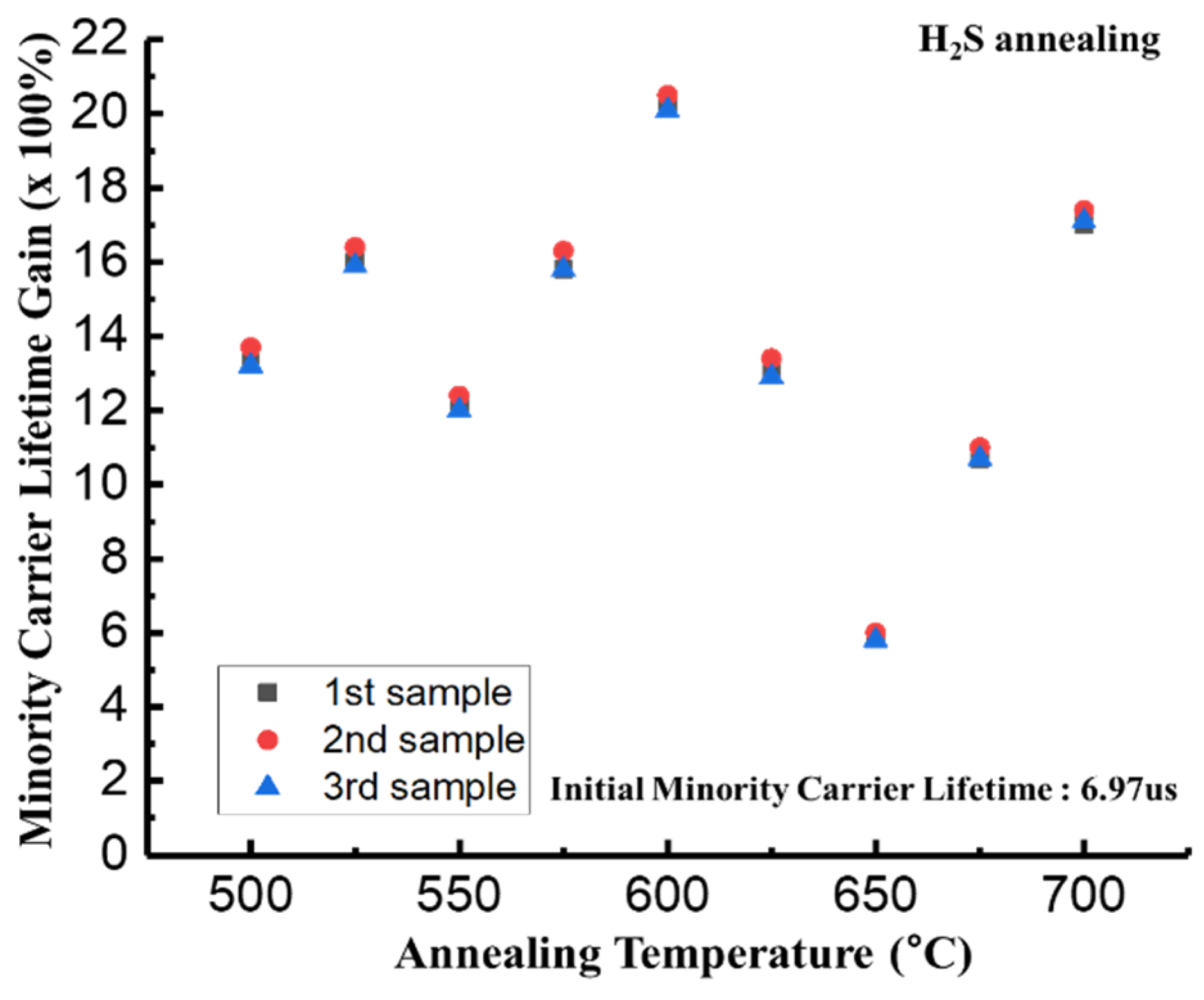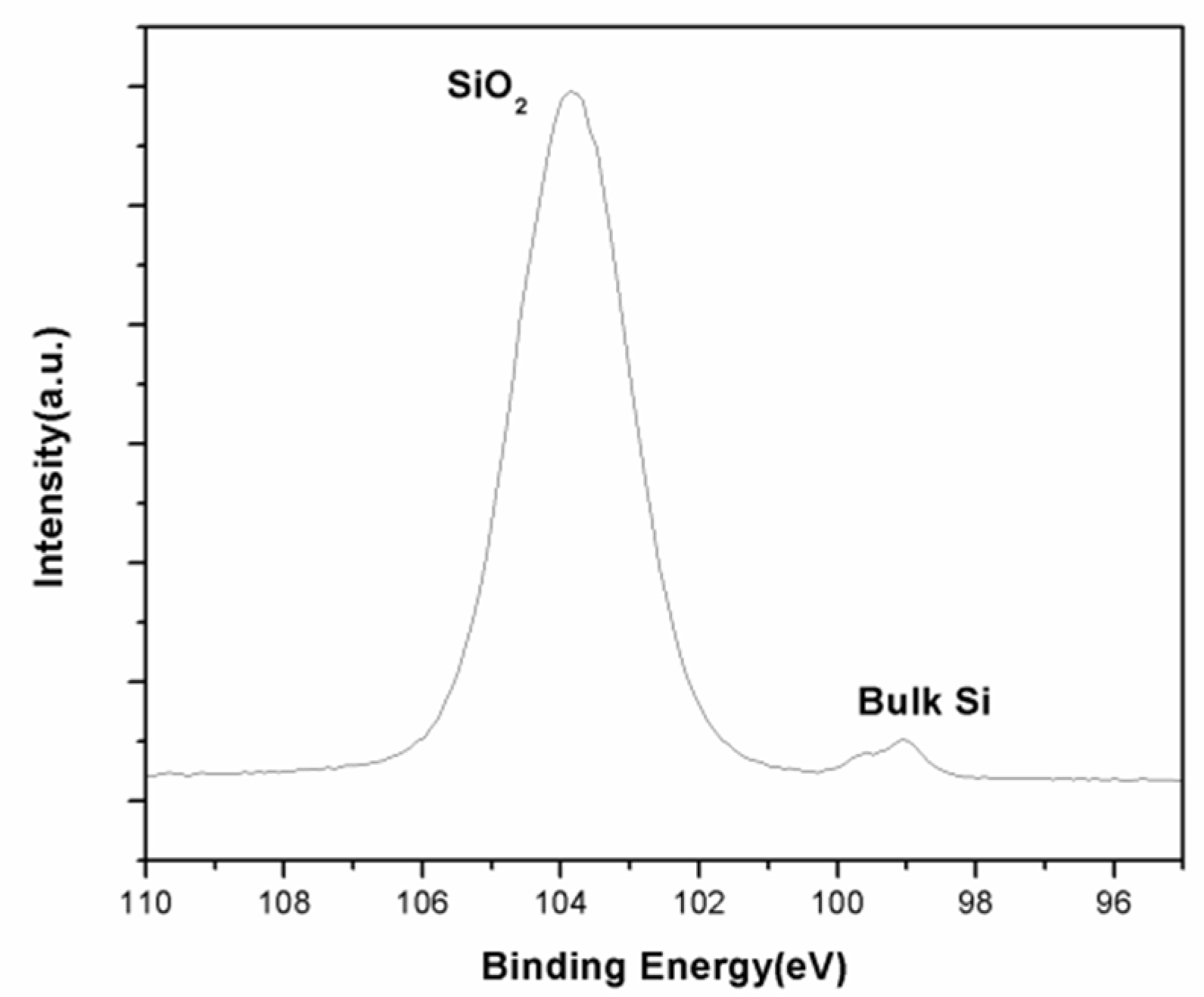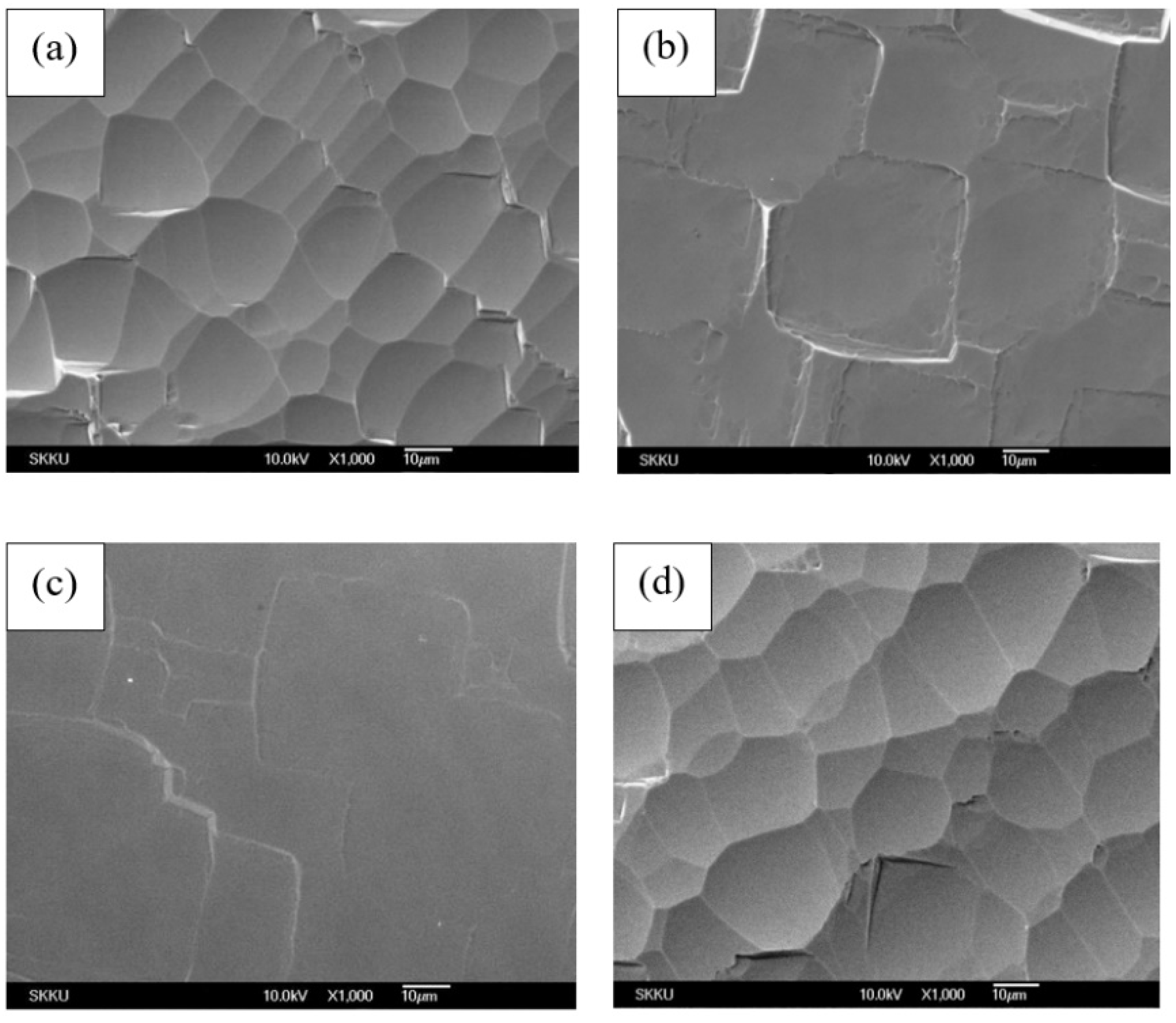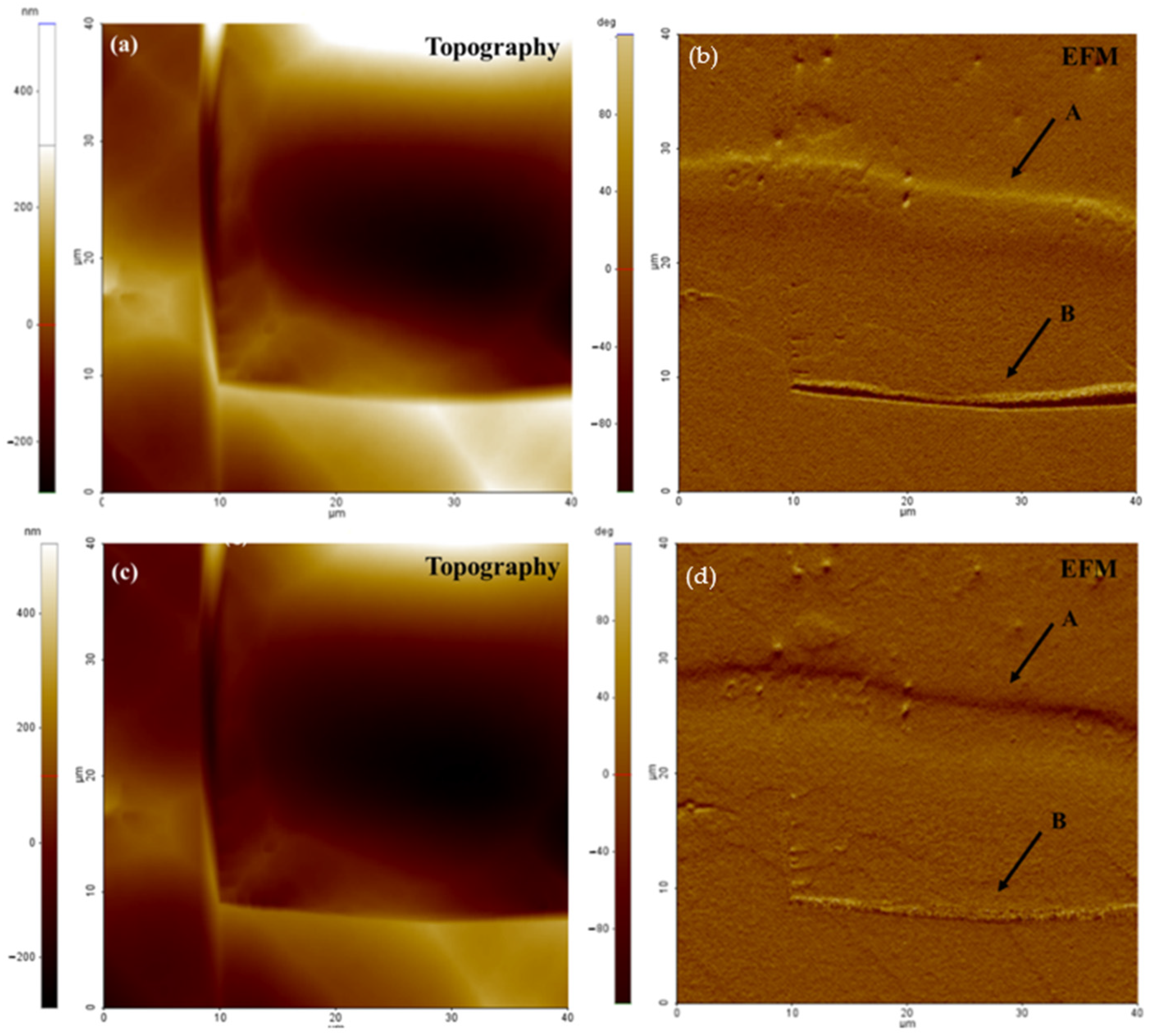Surface Passivation of Crystalline Silicon Wafer Using H2S Gas
Abstract
1. Introduction
2. Materials and Methods
3. Results and Discussion
4. Conclusions
Author Contributions
Funding
Data Availability Statement
Conflicts of Interest
References
- Hongsub, J.; Jinho, S.; Daehan, M.; Jaehyeong, L.; Chaehwan, J. Improvement in power of shingled solar cells for photo-voltaic module. J. Nanosci. Nanotechnol. 2020, 20, 7096–7099. [Google Scholar]
- Ajitha, A.; Nallapaneni, M.K.; Xiao, J.; Guduru, R.R.; Arunkumar, J.; Kadapalla, P.; Anil, K. Underwater performance of thin-film photovoltaic module immersed in shallow and deep waters along with possible applications. Results Phys. 2019, 15, 102768. [Google Scholar] [CrossRef]
- Pramod, R.; Maria, M.; Nallapaneni, M.K.; Sastry, O.S.; Arunkumar, J. Operational performance and degradation influenced life cycle environmental-economic metrics of mc-Si, a-Si and HIT photovoltaic arrays in hot semi-arid climates. Sustainability 2020, 12, 1075. [Google Scholar] [CrossRef]
- Anton, E.; Christian, R.; Armin, R.; Jan, B. Influence of layer thickness on passivation properties in SiOx/Al2O3 stacks. J. Appl. 2020, 127, 235303. [Google Scholar]
- Teng, C.K.; Kean, C.F.; Matthew, S.; Keith, M.; Evan, F.; Sieu, P.P.; Wensheng, L.; Andrew, B. Excellent ONO passivation on phosphorus and boron diffusion demonstrating a 25% efficient IBC solar cell. Prog. Photovolt. 2020, 28, 1034–1044. [Google Scholar]
- Kai-Yuan, C.; Shang-Chi, W.; Chia-Jui, Y.; Tong-Wen, W.; Jyun-Hao, L.; Meng-Chyi, W. Comparative study on performance of AlGaN/GaN MS-HEMTs with SiNx, SiOx, and SiNO surface passivation. Solid State Electron. 2020, 170, 107824. [Google Scholar]
- Mickael, L.; Shota, N.; Hitoshi, S.; Koji, M. Passivation property of ultrathin SiOx:H/a-Si:H stack layers for solar cell applications. Sol. Energy Mater. Sol. Cells 2018, 185, 8–15. [Google Scholar]
- Armin, G.A. Surface passivation of crystalline silicon solar cells: A review. Prog. Photovolt. 2000, 8, 473–487. [Google Scholar]
- Mohammad, Z.R.; Shahidul, I.K. Advances in surface passivation of c-Si solar cells. Mater. Renew. Sustain. Energy 2012, 1, 1–11. [Google Scholar]
- Zongjie, S.; Yanfei, Q.; Ivona, Z.M.; Cezhou, Z.; Steve, H.; Li, Y.; Tian, L.; Yanbo, H.; Chun, Z. Effect of annealing temperature for Ni/AlOx/Pt RRAM devices fabricated with solution-based dielectric. Micromachines 2019, 10, 446. [Google Scholar]
- Mead, C.; Spitzer, W.G. Fermi level position at metal-semiconductor interfaces. Phys. Rev. 1964, 134, A713–A716. [Google Scholar] [CrossRef]
- Muhammad, Y.A.; Meng, T. Effect of sulfur passivation of silicon (100) on Schottky barrier height: Surface states versus surface dipole. J. Appl. 2007, 101, 103708–1–103708–5. [Google Scholar]
- Ying-Huang, L.; Chuin-Tih, Y.; Yi-Hsin, L.; Wei-Hsiu, H. Adsorption and thermal decomposition of H2S on Si(100). Surf. Sci. 2002, 519, 150–156. [Google Scholar]
- Qifei, W.; Boris, V.Y.; Theodore, E.M. Adsorption and decomposition of H2S on UO2(001). Surf. Sci. 2003, 523, 1–11. [Google Scholar]
- Arunodoy, S.; Haifeng, Z.; Wen-Cheng, S.; Meng, T. A new method for bulk passivation in multicrystalline-Si by sulfur. In Proceedings of the IEEE 42nd Photovoltaic Specialist Conference (PVSC), New Orleans, LA, USA, 14–19 June 2015. [Google Scholar]
- John, V. Thin Film Processes, 1st ed.; Academic Press: Cambridge, MA, USA, 1978. [Google Scholar]
- Werner, K. Handbook of Semiconductor Cleaning Technology; Noyes Publishing: Park Ridge, NJ, USA, 1993. [Google Scholar]
- Jerry, G.F.; Fredrik, A.L. Theory of grain-boundary and intragrain recombination currents in polysilicon p-n-junction solar cells. IEEE Trans. Electron Devices 1980, 27, 692–700. [Google Scholar]
- Amal, K.G.; Charles, F.; Tom, F. Theory of the electrical and photovoltaic properties of polycrystalline silicon. J. Appl. 2008, 51, 446–454. [Google Scholar]
- Tae, J.S.; Young, J.C.; Hyun, S.J.; Dae, H.K.; Dae, W.K.; Sang-Moon, L.; Jong-Bong, P.; Jung-Yeon, W.; Seong, K.K.; Cheol, S.H.; et al. High quality interfacial sulfur passivation via H2S pre-deposition annealing for an atomic-layer deposited HfO2 film on a Ge substrate. J. Mater. Chem. C 2016, 4, 850–856. [Google Scholar]
- Wenwu, W.; Toshihide, N.; Yukihiro, S. Interface structure of HfNx/SiO2 stack grown by MOCVD using TDEAHf precursor. Surf. Sci. 2005, 588, 108–116. [Google Scholar]
- Hibino, Y.; Ishihara, S.; Oyanagi, Y.; Sawamoto, N.; Ohashi, T.; Matsuura, K.; Wakabayashi, H.; Ogura, A. Suppression of sulfur desorption of high-temperature sputtered MoS2 film by applying DC bias. ECS Trans. 2018, 85, 531–539. [Google Scholar] [CrossRef]
- Sana, R.; Alain, C.; Virginie, L.; Christian, V.; Jean-Michel, H.; Sebastien, B.; Nicolas, P. Isotropic dry etching of Si selectively to Si0.7Ge0.3 for CMOS sub-10 nm applications. J. Vac. Sci. Technol. 2020, 38, 033002. [Google Scholar]
- Jianhua, Z.; Aihua, W.; Martin, A.G. 19.8% efficient “honeycomb” textured multi-crystalline and 24.4% monocrystalline silicon solar cells. Appl. Phys. Lett. 1998, 73, 1991–1993. [Google Scholar]
- Bas, W.H.L.; Bart, M.; Manuel, S.; Maciej, K.S.; Agnes, A.M.; David, L.Y.; William, N.; Paul, S.; Wilhelmus, M.M.K. On the hydrogenation of Poly-Si passivating contacts by Al2O3 and SiNx thin films. Sol. Energy Mater. Sol. Cells 2020, 215, 110592. [Google Scholar]
- Wendell, D.E.; Richard, M.S. Calculation of surface generation and recombination velocities at the Si-SiO2 interface. J. Appl. Phys. 1985, 58, 4267–4276. [Google Scholar]
- Jerry, G.F. Physical operation of back-surface-field silicon solar cells. IEEE Trans. Electron Devices 1977, 24, 322–325. [Google Scholar]
- Morita, S.; Uchihashi, T.; Okamoto, K.; Abe, M.; Sugawara, Y. Microscale contact charging on a silicon oxide. In Scanning Probe Microscopy: Characterization, Nanofabrication and Device Application of Functional Materials; Vilarinho, P.M., Rosenwaks, Y., Kingon, A., Eds.; Kluwer Academic Publishers: Dordrecht, The Netherlands, 2002; Volume 186, pp. 289–308. [Google Scholar]





| H2S Annealing Temperature (°C) | 500 | 525 | 550 | 575 | 600 | 625 | 650 | 675 | 700 |
|---|---|---|---|---|---|---|---|---|---|
| Minority carrier lifetime gain (×100%) /standard deviation | 13.2/ 0.2517 | 16.1/ 0.2646 | 12.2/ 0.2 | 15.9/ 0.3601 | 20.3/ 0.1633 | 13.1/ 0.2646 | 5.9/ 0.1 | 10.8/ 0.1732 | 17.2/ 0.1732 |
Publisher’s Note: MDPI stays neutral with regard to jurisdictional claims in published maps and institutional affiliations. |
© 2021 by the authors. Licensee MDPI, Basel, Switzerland. This article is an open access article distributed under the terms and conditions of the Creative Commons Attribution (CC BY) license (https://creativecommons.org/licenses/by/4.0/).
Share and Cite
Lin, J.; Jee, H.; Yoo, J.; Yi, J.; Jeong, C.; Lee, J. Surface Passivation of Crystalline Silicon Wafer Using H2S Gas. Appl. Sci. 2021, 11, 3527. https://doi.org/10.3390/app11083527
Lin J, Jee H, Yoo J, Yi J, Jeong C, Lee J. Surface Passivation of Crystalline Silicon Wafer Using H2S Gas. Applied Sciences. 2021; 11(8):3527. https://doi.org/10.3390/app11083527
Chicago/Turabian StyleLin, Jian, Hongsub Jee, Jangwon Yoo, Junsin Yi, Chaehwan Jeong, and Jaehyeong Lee. 2021. "Surface Passivation of Crystalline Silicon Wafer Using H2S Gas" Applied Sciences 11, no. 8: 3527. https://doi.org/10.3390/app11083527
APA StyleLin, J., Jee, H., Yoo, J., Yi, J., Jeong, C., & Lee, J. (2021). Surface Passivation of Crystalline Silicon Wafer Using H2S Gas. Applied Sciences, 11(8), 3527. https://doi.org/10.3390/app11083527









